The term “recovery collar” is becoming the standard term to refer to what has been called an Elizabethan collar, a pet cone, or more humorously, a lampshade, a pet radar dish, and, of course, the misnomer “cone of shame.” There is no shame in needing help! The term Elizabethan collar is still heard frequently, but because it tends to be shortened to e-collar and because that’s also a shortened version of electronic collar, the phrase is falling out of use for this application.
It is normal for dogs to lick a wound, incision, bug bite, or irritated skin as part of normal grooming; it’s when that licking becomes excessive that a barrier device becomes necessary in order to prevent further injury.
Most dogs adjust to wearing a recovery collar fairly easily, but it can be an additional trauma for other dogs. Some will not eat or drink while wearing one and thus the collar must be temporarily removed at these times. Particularly shy or fearful dogs often have more difficulty navigating and become more concerned with the world when they have to wear a recovery collar. Some dogs become hypersensitive when their peripheral vision is hindered. And all dogs who are in discomfort and stressed will be more likely to act out aggressively in situations that would not normally bother them – and the stress can hinder healing, too!
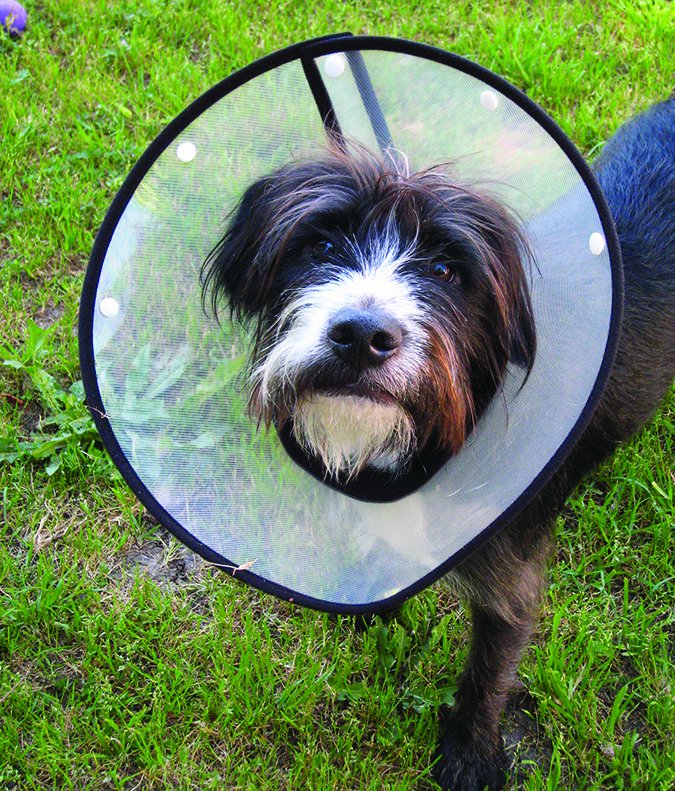
Fortunately, there are many dog cone alternatives to protect your dog’s stitches, hot spot, wound, or what-have-you. Some dog cone alternatives are designed to prevent the distress that some dogs experience when wearing a recovery collar; others are designed to work better with dogs of certain proportions (i.e., dogs with “no” necks, dogs with very long bodies or long legs, very small dogs, etc.).
Traits of Good Dog Cone Alternatives
If your dog is bothered by the impairment of his vision, look for products that allow him to look around, or are made of translucent material.
The sound of Velcro® or generic hook-and-loop closures can be scary to some dogs, so if your dog is one of these (or is phobic about odd noises), consider products that fasten with some other mechanism. These fasteners might also be problematic for dogs with long coats. A final consideration about hook-and-loop: the lifespan of the collar may also be reduced as the material degrades.
Properly fitting collars should be short enough to allow eating and drinking, yet prevent the wearer from reaching the area(s) of concern with his tongue or teeth. It should fit securely – you should be able to fit two fingers comfortably between the collar and neck – and yet not restrict breathing or swallowing. Unless provided and fitted by your veterinarian, you’ll need to know the circumference of your dog’s neck. An easy way to measure this is to remove your dog’s collar and measure the collar length. You may also need to know the length of your dog’s muzzle. Follow the manufacturer’s guide for measurements.
How to Use the Recovery Collar
It’s a great idea to shop for a recovery collar before your dog’s surgery, when he’s still feeling well. (If your dog is, fortunately, not scheduled for surgery, consider buying one in advance of any injury that might befall your dog!)
If possible, have your dog “try on” several different products, wearing them around the store for as much time as you can afford, to see how he deals with each product’s challenges. (And if your dog may have to wear one of these products for an extended period of time, consider buying a couple or several, so you can find the one that works best for him.)
Once you’ve settled on a product, and it’s time for the rubber to meet the road – or rather, for the dog to meet the collar – allow him to become familiar with the product before putting it on him; let him see and smell it first. Arm yourself with extra-delicious treats, and take your time when putting it on, rewarding him richly for his cooperation. Continue to offer him praise and reinforcement (treats) as he learns how to navigate wearing the new accessory. Carefully monitor your dog on his first days wearing a recovery collar, to see whether he can reach his wound around the collar – or reach the collar itself and destroy it!
Assist and guide your dog through doorways and up and down stairwells, as stairs can be a tripping hazard if they come into contact with the collar. Owners might consider clearing pathways and areas of items that can be knocked over by an inadvertent swipe of the recovery collar. Remember to give your dog breaks from wearing the collar when you’re home and can monitor him closely, so he doesn’t take the first opportunity to lick his wound.
Collars can get gross. Do take them off and wash them occasionally. Check daily around your dog’s head and neck for any area of irritation. Be aware that this accessory can get caught on objects, and paws can get caught in the collars themselves. When used for long periods, be mindful of your dog’s ears; some of these collars can trap moisture and heat, resulting in yeast growth or other ear issues.
The Best Kinds of Dog Cone Alternatives
There is no single style of recovery collar that fits all dogs and protects all wounds. Every dog is different in shape, flexibility, and emotional response to a recovery collar. The products reviewed here are sturdy, made of tough, flexible materials, reusable, and easily cleaned; all of them will store flat and some you can trim to size. Some will work better than others for certain dogs.
We’ve provided manufacturer information for the collars we reviewed, but bought them through Amazon. While we love the fast delivery (and often, the prices) from online sources, if the product doesn’t fit well, or fails to prevent your dog from reaching his wound, it might be more of a hassle to return it to an online seller than to take it back to a local pet supply store or veterinary hospital. (And, of course, you can bring your dog to a store and try them on there.)
Here is a comparison chart that highlights the various traits of recovery collars and cones. Scroll further to get written reviews of each collar tested.
| RECOVERY COLLARS AND BEST ALTERNATIVES | |||||||
| 4 paws = great | 3 paws = good | 2 paws = adequate | 1 paw = inadequate | ||||
| PRODUCT | PRICE | SIZES | FASTENER | VISION | HEARING | COMFORT | EASE OF MOVEMENT |
| STANDARD CONES (for comarison, not reviewed): stiff, opaque, plastic cone from your veterinarian | varies widely | many | usually tied to your dog’s collar with gauze |
 |
|||
Recovery Collar Reviews
Note: The products we reviewed are described in alphabetical order.
BiteNot
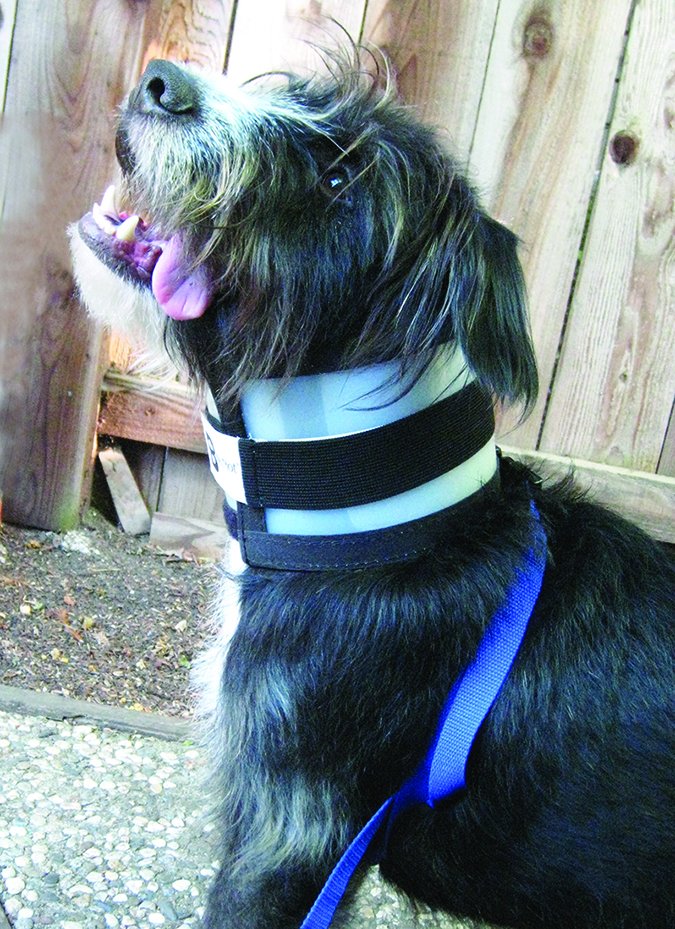
The BiteNot is designed like a cervical collar used by humans, and limits how far the dog can bend his neck, thus limiting the movement and reach of the dog’s head. It’s constructed with flexible plastic and foam, and wraps around your dog’s neck. It’s secured by a hook-and-loop (Velcro-like) closure and a harness strap that threads underneath the dog’s front legs and buckles at the back of the neck. The manufacturer states that it protects the back, rump, base of tail, flanks, chest, abdomen, and genitals. It is not designed to protect the ears or face, and the dog can reach the lower portion of his legs.
The BiteNot doesn’t interfere with the dog’s peripheral vision or ability to eat and drink. The length of collar must fit from behind the dog’s ears to the top of his shoulder, so sizing is key. This is the only collar of those reviewed here that caused a noticeable change in my dog when I tried it on him; he immediately became subdued. Which, if you need your dog to recover from something, might not be a bad thing – or a very bad thing, for a dog who got freaked out by the restriction of his neck movement.
PROS: Easy to put on. Does not inhibit vision. Interior nicely padded. Difficult for dog to remove. Machine washable.
CONS: Must be sized properly or it can hurt shoulders or ears. Heat and moisture can build up beneath collar. Has some potential for rubbing. Edges are hard; could be padded more.
Comfy Cone
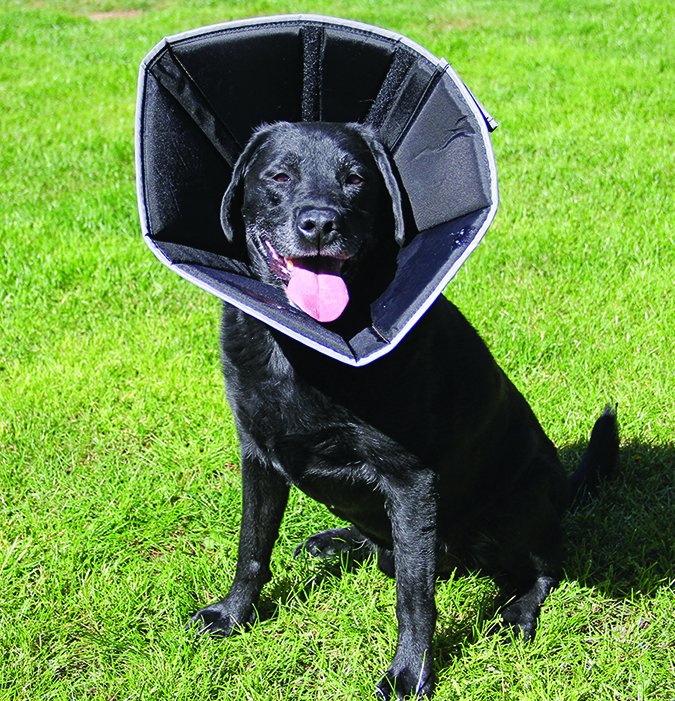
The Comfy Cone is a soft cone-shaped collar constructed of water-resistant nylon fabric, laminated to ½-inch foam, producing a cone that is soft and yielding, yet sturdy and protective.
It comes with removable stays that provide extra stability and stiffness for dogs/situations that call for this. The vertical Velcro-type strips allow for varying adjustments in size and fit; however when collar is fitted for maximum circumference the extra hook-and-loop strips are exposed and only one extra strip cover is provided. When the stays are removed, the edge of collar can be folded back to facilitate eating and drinking; but if you can fold the collar back, so can your dog.
The collar direction can be reversed for shoulder, chest, or upper back issues, as well as to cover IV lines and feeding tubes. When worn this way (see photo on cover), supervision is needed to ensure that your dog’s paws don’t get caught in the inverted cone.
PROS: Both a soft collar and hard collar. Water-resistant but machine washable. Has reflective binding for night safety. Conforms to different shapes. Heavy-duty hook-and-loop fastener secures collar well. Seems generally comfortable.
CONS: Solid fabric blocks peripheral vision. Interior is black; becomes hot and humid. Because edges can bend, some dogs may chew on it. Heavy duty Velcro-type fastener is noisy.
ElizaSoft Recovery Collar &
Trimline Recovery Collar
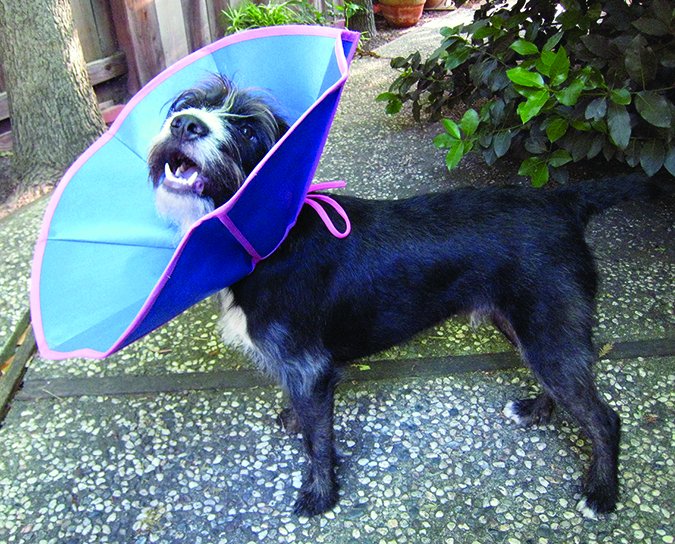
These soft-sided collars provide protection and freedom of movement for the head, neck, and body. Some veterinarians like this design because dogs tend to like it so owners like it, resulting in good compliance. Durably constructed, it withstands chewing and clawing, and is water repellent and machine washable. Sizing is flexible as the drawstring tie adjusts to different neck sizes. These work especially well for dogs in close confinement and for long recoveries.
PROS: Lightweight. Easy to put on. Built-in tie fastener is highly adjustable. Springs back to its original shape. Allows dog to sleep and lounge in comfort. Can be worn reversed to protect shoulder/back areas.
CONS: Because it is very flexible, dog can easily cause it to crumple and fold. Limits vision, as it is solid fabric.
FOREYY Recovery Pet Cone
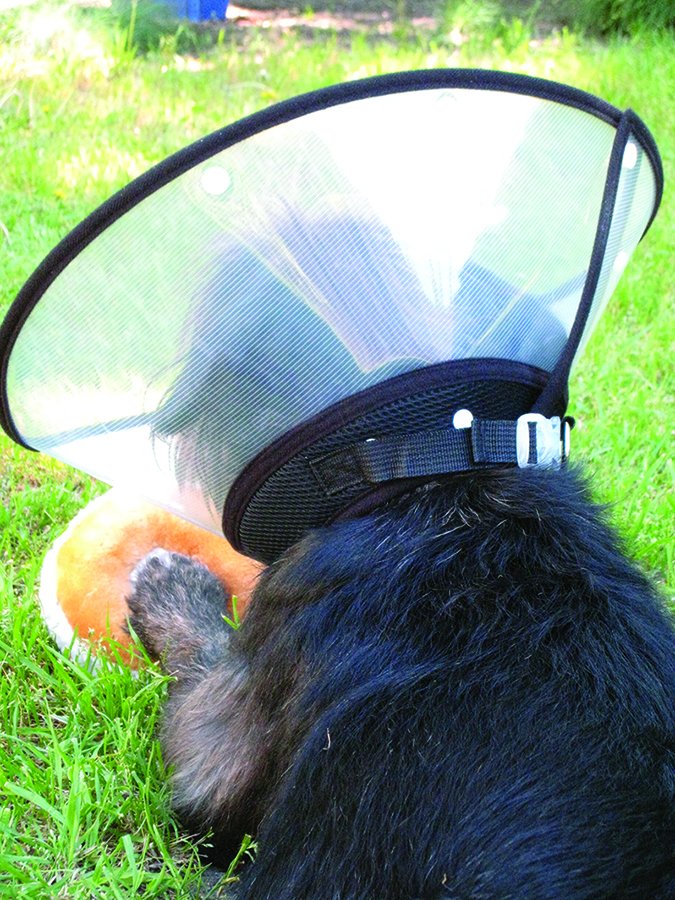
The FOREYY Recovery Pet Cone is a “softer” version of the standard plastic collar. It’s a slightly truncated cone with a wide band of breathable mesh fabric at its base. The “cone” is made of clear plastic, affording good visibility for the dog; this material is firm without being rigid, and the plastic edges are covered with fabric. This collar should provide good protection of most body parts if fitted correctly. The snap and buckle closures are secure and easily accessible.
One caution: This product has a built-in stainless steel D-ring, intended as an attachment for a leash. Leading a dog by the “cone” could seriously injure him; disregard this ring!
PROS: Snap closures (no Velcro). Allows dog to relax and sleep comfortably in any position. Easy to clean.
CONS: Limited size range; available only for small to medium dogs. Some dogs may reach tail and front paws. Might aggravate noise phobia.
KONG Cloud Collar

The KONG Cloud Collar (a.k.a. the airplane neck pillow that I am taking with me the next time I fly) is a well-designed and comfortable recovery collar. It allows dogs to eat, drink, and sleep and does not interfere with peripheral vision.
It is easy to put on – simply thread your dog’s regular collar through the interior of the pillow and inflate via the pinch and blow air valve, inflating to full but not hard. Its security is dependent on the fit of your dog’s regular collar; if the collar can slip or be pulled over his head, he will be able to get the Cloud Collar off, too. My dog Tico had this collar off in seconds off by putting his paws behind the donut and pulling his head right out.
The Cloud Collar is not good for any issue around the face or ears and may not prevent access to some areas on the body, such as the tail. It is a good option for brachycephalic dogs because it’s difficult for them to get off. Some users report that the hook-and-loop closure can rub.
PROS: Machine washable, scratch-, tear-, and rip-resistant fabric. Does not mark or scratch furniture. Great for playing and easy for dog to adjust to. Seems to be more comfortable than other styles. Dog can eat, drink, and sleep easily.
CONS: Has potential for deflating (popping/leaking air) and for irritation due to heat. Prevents dog from being able to lie flat.
NACOCO
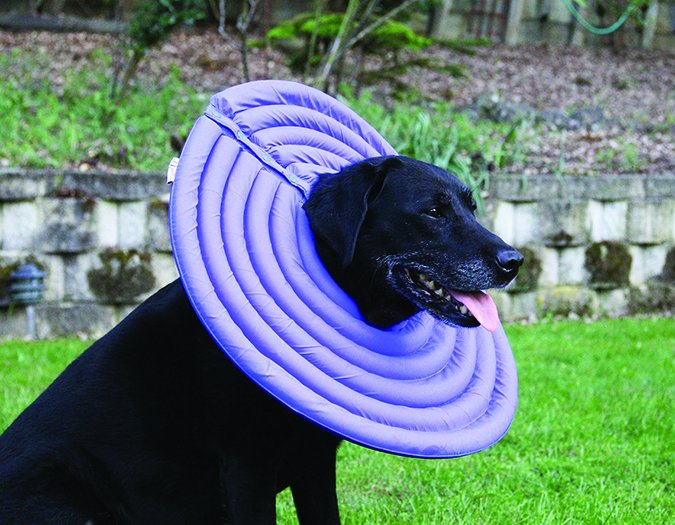
Perhaps the goofiest-looking recovery collar we tried, the NACOCO is made of soft, hollow, expanded polyethylene foam, covered in a water-resistant nylon fabric. Very soft and lightweight, it’s potentially useful for shoulder and chest issues. It doesn’t impede the ability to eat, drink, see, or hear. Because it is so large, I thought dogs wouldn’t like wearing it; surprisingly, none of the dogs I tested it on had any difficulty adjusting to it.
PROS: Does not hurt when it collides with humans. Lightweight. Flexible enough to bend when going through a narrow doorways and to allow dogs to lay down comfortably.
CONS: Can be an impediment to movement of the front legs; does not work well for short-legged dogs as it hits the ground. Flexibility also poses potential for chewing or for dog to reach his wound around collar. The fixed snap closure does not allow for any adjusting of size.
Novaguard
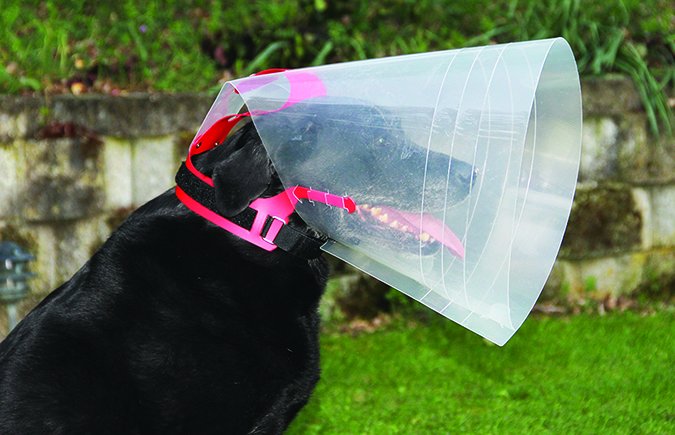
The Novaguard is much narrower than standard plastic cones, giving the dog greater freedom of movement. It resembles a transparent knight’s helmet – but one that’s ergonomically designed to fit a dog’s head.
The plastic is hard and the edges are not padded, but the manufacturer addresses this with the explanation that this keeps the product affordable; it suggests that customers can create custom cushioning or trim the edges if necessary with medical tape.
The pre-scored grooves at the outer rim allow for individual sizing for muzzle length. This is a good option for dogs with long, lean necks or long muzzles. The company also makes The Optivizor, for eye and face protection.
This is one of those products that will either fit your dog perfectly or not at all, depending on his shape. Even though we had this fitted snugly on one of the models (and it has the potential to be set too tight) the construction is such that it slipped forward and then off the model’s head without undoing the hook-and-loop neck strap.
PROS: Slim design, fits closer to head and thus protects eyes and muzzle. The dog’s ears are outside of collar, eliminating sound amplification and buildup of moisture or heat around ears. Should protect most areas of trauma except ears.
CONS: Not many adjustment points. Hard plastic could be uncomfortable; potential for rubbing. Assembly required.
ZenCone Soft Recovery Collar
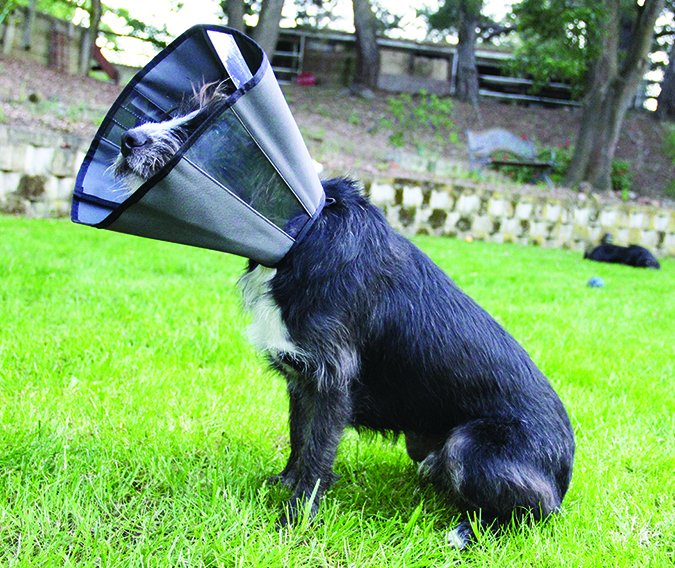
A hybrid design, ZenCone is made of alternating bands of soft canvas and plastic windows, which offer peripherl vision. It attaches to the dog’s regular collar with elastic loops, and the cone shape and size easily adjusts with strips of hook-and-loop material.
PROS: Flexible and comfortable for sleeping. Human- and house-friendly. Easy to put on and take off. Fabric reduces the distortion and amplification of noise caused by some cone designs.
CONS: When sized for smaller dogs, exposed strips of unused hook-and-loop fasteners can collect lint and stick to carpet and fabrics. May not be deep enough and too flexible to prevent long-nosed or determined dogs from reaching wounds.
Custom Collars
Sometimes, none of the purpose-made recovery collars will work. My friend Joanne made her own recovery collar for her dog out of foam and heavy-duty fabric; I think she should start production and sales! At times, temporary measures are needed. With a little creativity, you can quickly create a makeshift collar with a few household items. People have been known to use cardboard, actual lampshades, wastebaskets, and plastic flowerpots. Whatever works!
Erin Einbender, a volunteer at Chicago-area rescue group One Tail at a Time and an artist studying at the School of Art Institute in Chicago, combined her passion for dogs and photography and created the Cones of Fame project. Think “art meets dogs meets recovery collars.”
Erin not only creates art using recovery collars as a canvas, but also helps find homes for the canine models. While we can’t recommend using these types of collars for
actual recovery, we do support the endeavor. Check out Cones of Fame (and adoptable dogs!) online.
Barbara Dobbins, a former dog trainer, writes about dogs and studies canine ethology. She lives in the San Francisco Bay area with her mixed-breed adolescent dog, Tico.


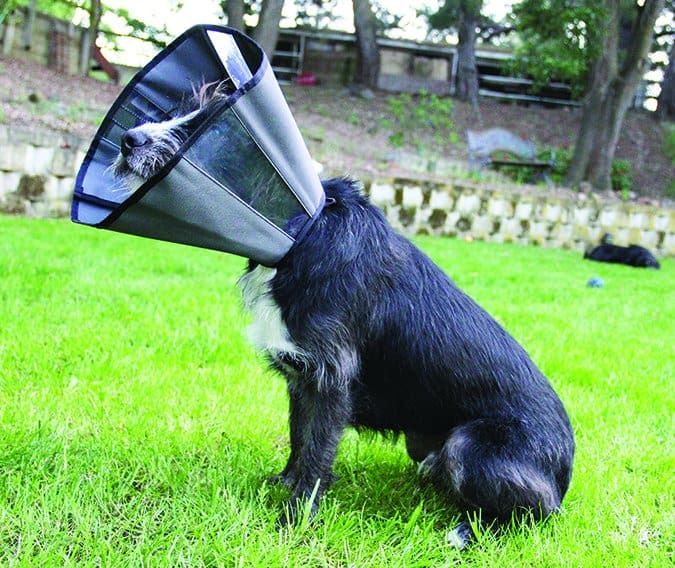
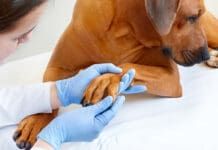
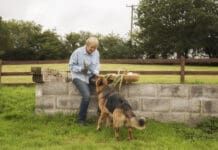
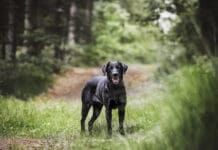
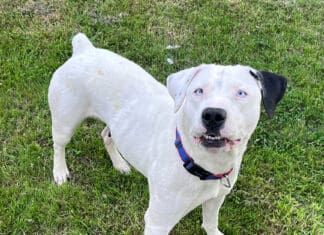
Woe is for the person and dog that have lower leg issues. When you have a large dog with wounds close to the skin on the lower leg, there are no E-collars you can buy that extend out long enough to keep the licking and chewing dog from making a mess of any efforts you’ve made to help heal. Going into the 2nd week, have two E-collars that have been re-engineered to accommodate the long back legs of this pooch. Cannot leave the collar off for one minute so I have two. She is a rough play 10 mos Rottweiler and despises the collar. Duck tape to the rescue.